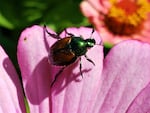These clumsy-flying guys and gals especially love roses, hops, wine and juice grapes – they even like cherries. The invasive Japanese beetles – smaller than a penny – have been found munching their way across western Oregon’s Washington County. And there’s a hotspot in the Yakima Valley in Grandview.
The beetles are voracious and can quickly eat crops and roses to nubs – leaving just a leaf skeleton behind. Agriculture officials worry they could eventually do millions of dollars in damage to valuable Northwest crops if not stopped.
“The ability to reside and feed upon many plants within our cities and towns is very difficult,” said Cody Holthouse, the program manager of insect pest prevention and management with Oregon’s Department of Agriculture. “It is kind of intense. It speaks to how voracious they are as pests. I’ve heard of people in the east [coast] say that there will be so many adults [beetles] that you can almost hardly see the flower petals, there are so many of them there feeding and making a mess of things.”

Adult Japanese beetles can take plants like roses, grapes or hops down to the nubs quickly if infested. The beetle comes from Asia, and doesn’t have many predators in Oregon and Washington.
Courtesy Washington State Department of Agriculture
Both Oregon and Washington have eradication programs going – they treat lawns with insecticide to kill the larvae before they emerge as adults for the season and become harder to track down.
Thousands of letters are sent each year to people within the zones asking them to consent to the treatment plans.
In Washington, there’s now an expanded 74-square-mile zone where officials are trying to treat lawns for the pest.
That’s expanded from last year’s 49-square-mile eradication area.
They try to catch the larvae of the beetles before they emerge in the spring by spraying lawns – or using a granular form – where the beetles eat grass roots over the winter.
Some Washington farmers are having to prove – through trapping – they don’t have the pest before they can move their crops, like hops.
In Oregon, the pests are found in a more residential-urban environment to the west of Portland, including Cedar Mill, Bonny Slope, Oak Hills and Bethany. Yard waste is more of a problem in those burgs.
Holthouse says it’s a lot like fighting a wildland fire.
“As we dwindle this population down, there will be more and more spread out satellite populations,” he says. “It’s very much like fighting fire. Just like a fire might jump the line, and move with the wind. A Japanese beetle might jump into a truck and move with lawn clippings to another location.”
Another challenge for Washington state officials is that Interstate 82 runs right through the area infested with beetles. It’s a major agricultural transport route.
Camilo Acosta, Washington State Department of Agriculture’s eradication project coordinator, says the interstate could be an escape route for some of the beetles. He says they’re clumsy fliers, but they often fly toward the perfume of plants like hops, or fruit. So, truckloads of the freshly-harvested crops smell like hot lunch to these hungry insects who might hitch a ride to another area in the state, or another state completely.
Progress buzzing in Oregon, it’s tough in Washington
The WSDA found more than 23,000 beetles in the Grandview area in 2022. The state is treating properties with insecticide in and around the infested area, including private property.
Acelepryn is the name of the product both states are using. It’s considered a low-risk insecticide that is not hazardous to humans or domestic animals, Washington state officials said in a press release. Contractors spray the product to plant foliage or directly to lawns. And the insecticide can also be in a granular form, applied with seed spreaders.
"Other Japanese beetle eradication projects across the Northwest have shown that a single application to the soil with the pesticide Acelepryn in late April or early May would be the best option," Acosta said in a press release. "There may be highly infested areas that will need a second application sprayed directly on the foliage of the plants."
In Oregon, there is a roughly 3,000-acre affected area being treated, according to Oregon’s Department of Agriculture. So far that program has seen a more than 80% reduction in total beetle catches. In 2017, about 23,480 beetles were caught, but last year a record-low for the area of 3,254 beetles were captured.
Holthouse says Oregon officials are intensively trapping and treating vegetation for the beetles, at a cost of about $1 million per year since 2017.
If you see a beetle, Holthouse says, give it a good stomp. Then burn it or flush it down the toilet. Make sure it’s not coming back.
“As an entomologist, we very rarely get to utter the word eradication, we usually talk about management,” Holthouse said. “We’re really hopeful we can smite this pest out of the state completely. We know we’re working with the remaining remnants of the population now.”